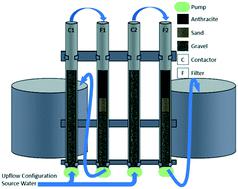当前位置:
X-MOL 学术
›
Environ. Sci.: Water Res. Technol.
›
论文详情
Our official English website, www.x-mol.net, welcomes your feedback! (Note: you will need to create a separate account there.)
The removal of ammonia, arsenic, iron and manganese by biological treatment from a small Iowa drinking water system
Environmental Science: Water Research & Technology ( IF 5 ) Pub Date : 2020-09-22 , DOI: 10.1039/d0ew00361a Darren A Lytle 1 , Daniel Williams 1 , Christy Muhlen 1 , Eugenia Riddick 1 , Maily Pham 1
Environmental Science: Water Research & Technology ( IF 5 ) Pub Date : 2020-09-22 , DOI: 10.1039/d0ew00361a Darren A Lytle 1 , Daniel Williams 1 , Christy Muhlen 1 , Eugenia Riddick 1 , Maily Pham 1
Affiliation

|
Although not regulated in United States drinking water, ammonia has the potential to increase chlorine consumption and cause nitrification problems in the distribution system. Many groundwaters with elevated ammonia are also contaminated with other inorganic analytes such as arsenic, iron, and manganese, all of which have primary or secondary maximum contaminant levels (MCLs). The objective of this work was to demonstrate the effectiveness of an innovative biological treatment process to simultaneously remove ammonia (2.9 mg N per L), arsenic (23 μg L−1), iron (2.9 mg L−1) and manganese (80 μg L−1) from a groundwater source in Iowa. The biological treatment system consisted of an “aeration contactor” followed by a conventional granular media filter. Orthophosphate was also added, as a biological nutrient, at 0.3 mg PO4 per L. Ammonia, manganese, and iron were consistently reduced through the pilot system by 98 to 99%. Complete oxidation of ammonia to nitrate was observed (i.e., no nitrite was released) and arsenic was consistently removed to below the 10 μg L−1 MCL. Ammonia was oxidized by ammonia and nitrite oxidizing bacteria and arsenic by bacteria which converted As(III) in the source water to more readily removable As(V). Iron was presumably oxidized by oxygen during aeration although some biologically assisted oxidation could not be ruled out. As(V) bound iron particles were removed in the filter resulting in effective arsenic (and iron) reduction. A surprising treatment benefit was the effective manganese reduction, the mechanism of which was not so clear, but was attributed to biologically assisted oxidation of Mn(II). While some system acclimation time was necessary to achieve desired ammonia and manganese reductions, acceptable arsenic and iron reductions were observed shortly after start-up.
中文翻译:

通过生物处理去除爱荷华州小型饮用水系统中的氨、砷、铁和锰
尽管在美国饮用水中没有受到管制,但氨有可能增加氯的消耗量并导致分配系统中的硝化问题。许多氨含量升高的地下水还受到其他无机分析物的污染,如砷、铁和锰,所有这些都具有一级或二级最大污染物水平 (MCL)。这项工作的目的是证明一种创新的生物处理工艺能够同时去除氨(2.9 mg N/L)、砷(23 μg L -1)、铁(2.9 mg L -1)和锰(80 μg L -1) 来自爱荷华州的地下水源。生物处理系统由一个“曝气接触器”和一个传统的颗粒介质过滤器组成。还添加了作为生物营养物的正磷酸盐,每升0.3 毫克 PO 4。氨、锰和铁通过中试系统始终减少 98% 到 99%。观察到氨完全氧化成硝酸盐(即没有释放亚硝酸盐)并且砷被一致地去除至低于10μg L -1 MCL。氨被氨和亚硝酸盐氧化细菌氧化,砷被细菌氧化,这些细菌将源水中的As( III )转化为更容易去除的 As( V))。铁可能在曝气过程中被氧气氧化,尽管不能排除一些生物辅助氧化。As( V ) 结合的铁颗粒在过滤器中被去除,从而有效地减少砷(和铁)。一个令人惊讶的治疗益处是有效的锰还原,其机制尚不清楚,但归因于 Mn( II ) 的生物辅助氧化。虽然需要一些系统适应时间来实现所需的氨和锰还原,但在启动后不久观察到可接受的砷和铁还原。
更新日期:2020-10-02
中文翻译:

通过生物处理去除爱荷华州小型饮用水系统中的氨、砷、铁和锰
尽管在美国饮用水中没有受到管制,但氨有可能增加氯的消耗量并导致分配系统中的硝化问题。许多氨含量升高的地下水还受到其他无机分析物的污染,如砷、铁和锰,所有这些都具有一级或二级最大污染物水平 (MCL)。这项工作的目的是证明一种创新的生物处理工艺能够同时去除氨(2.9 mg N/L)、砷(23 μg L -1)、铁(2.9 mg L -1)和锰(80 μg L -1) 来自爱荷华州的地下水源。生物处理系统由一个“曝气接触器”和一个传统的颗粒介质过滤器组成。还添加了作为生物营养物的正磷酸盐,每升0.3 毫克 PO 4。氨、锰和铁通过中试系统始终减少 98% 到 99%。观察到氨完全氧化成硝酸盐(即没有释放亚硝酸盐)并且砷被一致地去除至低于10μg L -1 MCL。氨被氨和亚硝酸盐氧化细菌氧化,砷被细菌氧化,这些细菌将源水中的As( III )转化为更容易去除的 As( V))。铁可能在曝气过程中被氧气氧化,尽管不能排除一些生物辅助氧化。As( V ) 结合的铁颗粒在过滤器中被去除,从而有效地减少砷(和铁)。一个令人惊讶的治疗益处是有效的锰还原,其机制尚不清楚,但归因于 Mn( II ) 的生物辅助氧化。虽然需要一些系统适应时间来实现所需的氨和锰还原,但在启动后不久观察到可接受的砷和铁还原。



























 京公网安备 11010802027423号
京公网安备 11010802027423号